中美高校招生制度的比较
- 格式:doc
- 大小:20.33 KB
- 文档页数:9
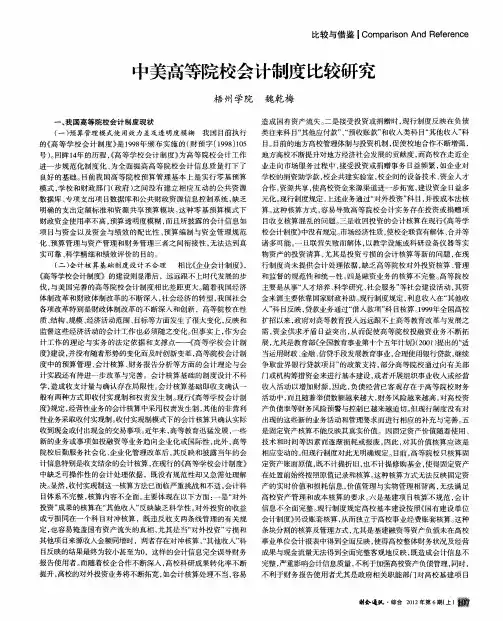
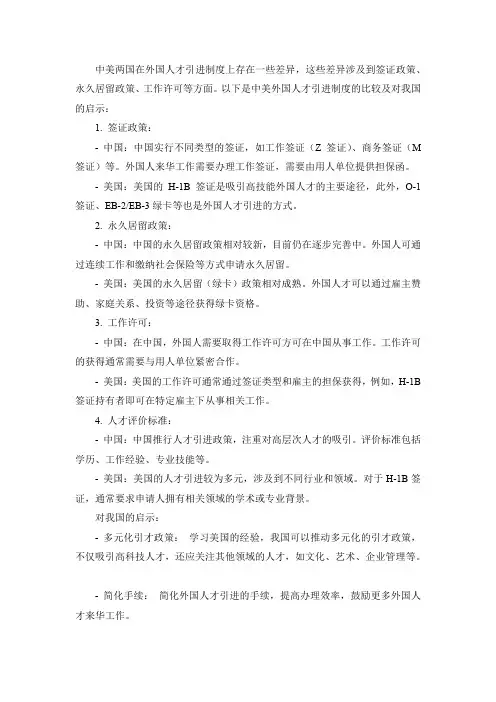
中美两国在外国人才引进制度上存在一些差异,这些差异涉及到签证政策、永久居留政策、工作许可等方面。
以下是中美外国人才引进制度的比较及对我国的启示:1. 签证政策:-中国:中国实行不同类型的签证,如工作签证(Z签证)、商务签证(M 签证)等。
外国人来华工作需要办理工作签证,需要由用人单位提供担保函。
-美国:美国的H-1B签证是吸引高技能外国人才的主要途径,此外,O-1签证、EB-2/EB-3绿卡等也是外国人才引进的方式。
2. 永久居留政策:-中国:中国的永久居留政策相对较新,目前仍在逐步完善中。
外国人可通过连续工作和缴纳社会保险等方式申请永久居留。
-美国:美国的永久居留(绿卡)政策相对成熟。
外国人才可以通过雇主赞助、家庭关系、投资等途径获得绿卡资格。
3. 工作许可:-中国:在中国,外国人需要取得工作许可方可在中国从事工作。
工作许可的获得通常需要与用人单位紧密合作。
-美国:美国的工作许可通常通过签证类型和雇主的担保获得,例如,H-1B 签证持有者即可在特定雇主下从事相关工作。
4. 人才评价标准:-中国:中国推行人才引进政策,注重对高层次人才的吸引。
评价标准包括学历、工作经验、专业技能等。
-美国:美国的人才引进较为多元,涉及到不同行业和领域。
对于H-1B签证,通常要求申请人拥有相关领域的学术或专业背景。
对我国的启示:-多元化引才政策:学习美国的经验,我国可以推动多元化的引才政策,不仅吸引高科技人才,还应关注其他领域的人才,如文化、艺术、企业管理等。
-简化手续:简化外国人才引进的手续,提高办理效率,鼓励更多外国人才来华工作。
-建立健全的永久居留政策:完善永久居留政策,为外国人提供更多长期发展的机会,增强吸引力。
-人才评价标准:制定更为科学和综合的人才评价标准,不仅关注学术背景和专业技能,还应考虑工作经验、实际贡献等方面。
总体而言,中美外国人才引进制度的比较为我国提供了借鉴和完善的空间,有助于构建更具竞争力的人才引进制度。
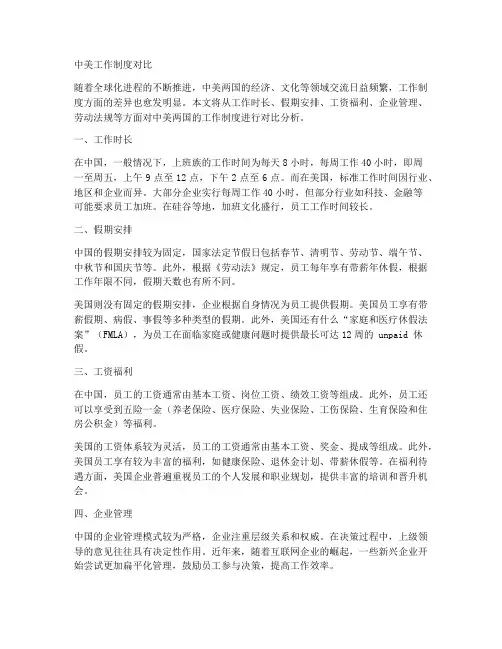
中美工作制度对比随着全球化进程的不断推进,中美两国的经济、文化等领域交流日益频繁,工作制度方面的差异也愈发明显。
本文将从工作时长、假期安排、工资福利、企业管理、劳动法规等方面对中美两国的工作制度进行对比分析。
一、工作时长在中国,一般情况下,上班族的工作时间为每天8小时,每周工作40小时,即周一至周五,上午9点至12点,下午2点至6点。
而在美国,标准工作时间因行业、地区和企业而异。
大部分企业实行每周工作40小时,但部分行业如科技、金融等可能要求员工加班。
在硅谷等地,加班文化盛行,员工工作时间较长。
二、假期安排中国的假期安排较为固定,国家法定节假日包括春节、清明节、劳动节、端午节、中秋节和国庆节等。
此外,根据《劳动法》规定,员工每年享有带薪年休假,根据工作年限不同,假期天数也有所不同。
美国则没有固定的假期安排,企业根据自身情况为员工提供假期。
美国员工享有带薪假期、病假、事假等多种类型的假期。
此外,美国还有什么“家庭和医疗休假法案”(FMLA),为员工在面临家庭或健康问题时提供最长可达12周的 unpaid 休假。
三、工资福利在中国,员工的工资通常由基本工资、岗位工资、绩效工资等组成。
此外,员工还可以享受到五险一金(养老保险、医疗保险、失业保险、工伤保险、生育保险和住房公积金)等福利。
美国的工资体系较为灵活,员工的工资通常由基本工资、奖金、提成等组成。
此外,美国员工享有较为丰富的福利,如健康保险、退休金计划、带薪休假等。
在福利待遇方面,美国企业普遍重视员工的个人发展和职业规划,提供丰富的培训和晋升机会。
四、企业管理中国的企业管理模式较为严格,企业注重层级关系和权威。
在决策过程中,上级领导的意见往往具有决定性作用。
近年来,随着互联网企业的崛起,一些新兴企业开始尝试更加扁平化管理,鼓励员工参与决策,提高工作效率。
美国的企业管理模式相对宽松,注重团队合作和创造力。
企业鼓励员工提出建议,参与决策。
在管理风格上,美国企业更加注重人性化、平等和尊重员工。
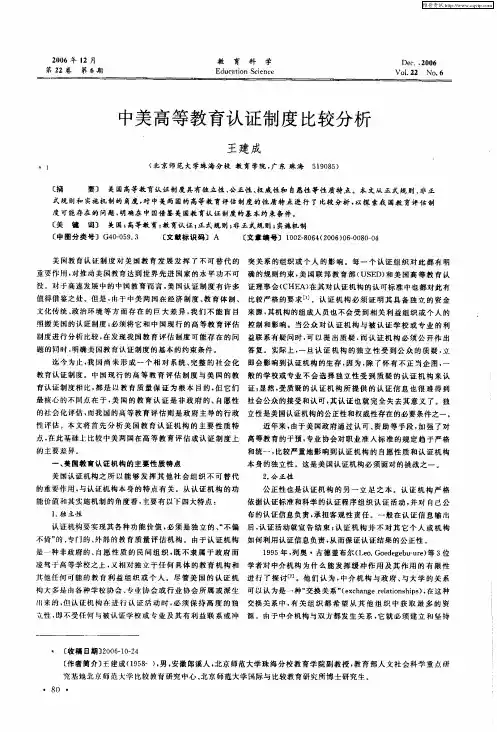
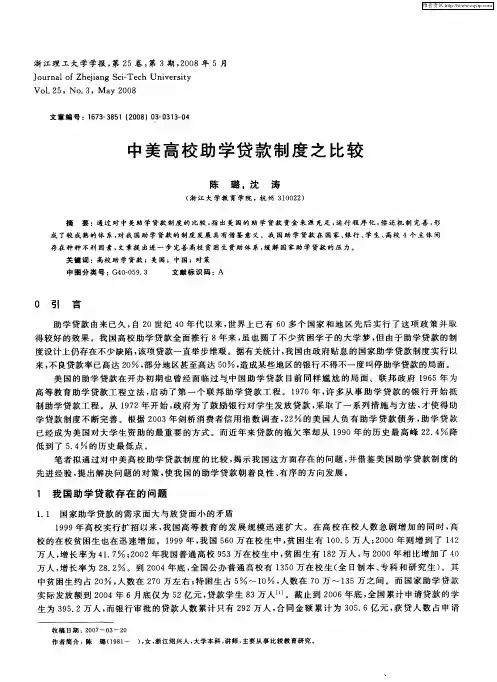
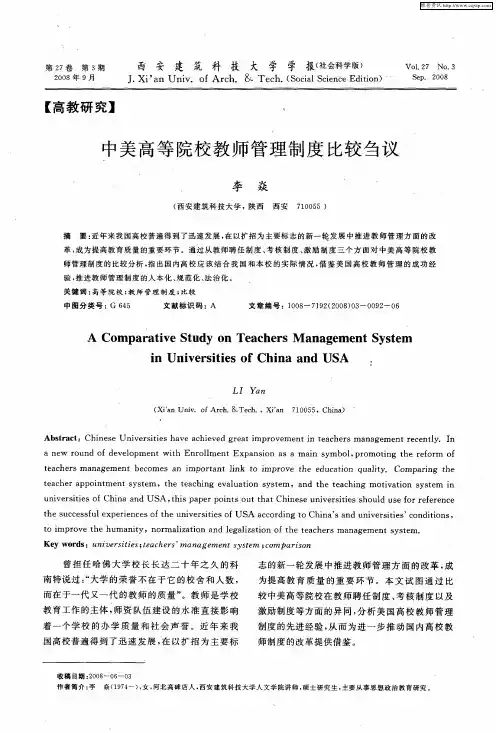
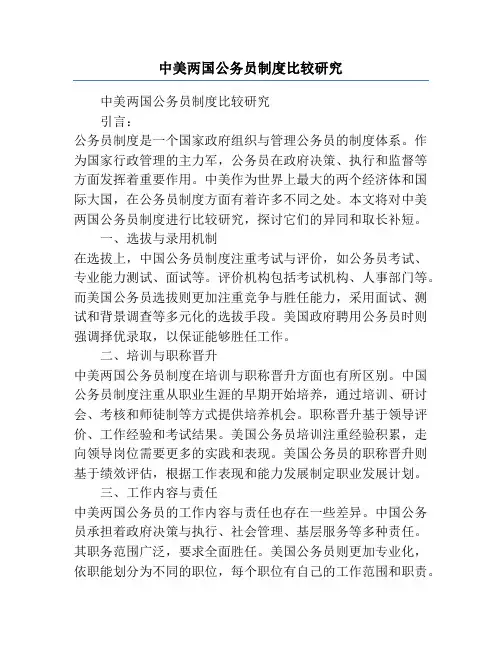
中美两国公务员制度比较研究中美两国公务员制度比较研究引言:公务员制度是一个国家政府组织与管理公务员的制度体系。
作为国家行政管理的主力军,公务员在政府决策、执行和监督等方面发挥着重要作用。
中美作为世界上最大的两个经济体和国际大国,在公务员制度方面有着许多不同之处。
本文将对中美两国公务员制度进行比较研究,探讨它们的异同和取长补短。
一、选拔与录用机制在选拔上,中国公务员制度注重考试与评价,如公务员考试、专业能力测试、面试等。
评价机构包括考试机构、人事部门等。
而美国公务员选拔则更加注重竞争与胜任能力,采用面试、测试和背景调查等多元化的选拔手段。
美国政府聘用公务员时则强调择优录取,以保证能够胜任工作。
二、培训与职称晋升中美两国公务员制度在培训与职称晋升方面也有所区别。
中国公务员制度注重从职业生涯的早期开始培养,通过培训、研讨会、考核和师徒制等方式提供培养机会。
职称晋升基于领导评价、工作经验和考试结果。
美国公务员培训注重经验积累,走向领导岗位需要更多的实践和表现。
美国公务员的职称晋升则基于绩效评估,根据工作表现和能力发展制定职业发展计划。
三、工作内容与责任中美两国公务员的工作内容与责任也存在一些差异。
中国公务员承担着政府决策与执行、社会管理、基层服务等多种责任。
其职务范围广泛,要求全面胜任。
美国公务员则更加专业化,依职能划分为不同的职位,每个职位有自己的工作范围和职责。
他们的工作更多侧重于专业知识的应用和政策的执行。
四、任职稳定性在任职稳定性方面,中国公务员制度更加稳定。
中国公务员享有相对较高的保障和福利待遇,并且有着相对较长的任期,很少有公务员被解雇。
美国公务员则更容易受到政府政策变化的影响,政府职位可能会被削减或废除,需要更加适应政府运作的变化。
结论:中美两国公务员制度在选拔与录用机制、培训与职称晋升、工作内容与责任以及任职稳定性等方面存在差异。
中国公务员制度更加强调考试与评价,提供更多的保障与福利待遇,但也给予公务员较少自主权。
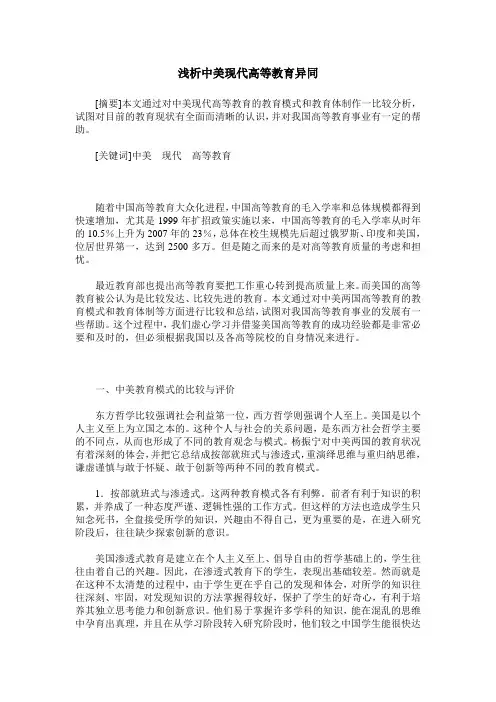
浅析中美现代高等教育异同[摘要]本文通过对中美现代高等教育的教育模式和教育体制作一比较分析,试图对目前的教育现状有全面而清晰的认识,并对我国高等教育事业有一定的帮助。
[关键词]中美现代高等教育随着中国高等教育大众化进程,中国高等教育的毛入学率和总体规模都得到快速增加,尤其是1999年扩招政策实施以来,中国高等教育的毛入学率从时年的10.5%上升为2007年的23%,总体在校生规模先后超过俄罗斯、印度和美国,位居世界第一,达到2500多万。
但是随之而来的是对高等教育质量的考虑和担忧。
最近教育部也提出高等教育要把工作重心转到提高质量上来。
而美国的高等教育被公认为是比较发达、比较先进的教育。
本文通过对中美两国高等教育的教育模式和教育体制等方面进行比较和总结,试图对我国高等教育事业的发展有一些帮助。
这个过程中,我们虚心学习并借鉴美国高等教育的成功经验都是非常必要和及时的,但必须根据我国以及各高等院校的自身情况来进行。
一、中美教育模式的比较与评价东方哲学比较强调社会利益第一位,西方哲学则强调个人至上。
美国是以个人主义至上为立国之本的。
这种个人与社会的关系问题,是东西方社会哲学主要的不同点,从而也形成了不同的教育观念与模式。
杨振宁对中美两国的教育状况有着深刻的体会,并把它总结成按部就班式与渗透式,重演绎思维与重归纳思维,谦虚谨慎与敢于怀疑、敢于创新等两种不同的教育模式。
1.按部就班式与渗透式。
这两种教育模式各有利弊。
前者有利于知识的积累,并养成了一种态度严谨、逻辑性强的工作方式。
但这样的方法也造成学生只知念死书,全盘接受所学的知识,兴趣由不得自己,更为重要的是,在进入研究阶段后,往往缺少探索创新的意识。
美国渗透式教育是建立在个人主义至上、倡导自由的哲学基础上的,学生往往由着自己的兴趣。
因此,在渗透式教育下的学生,表现出基础较差。
然而就是在这种不太清楚的过程中,由于学生更在乎自己的发现和体会,对所学的知识往往深刻、牢固,对发现知识的方法掌握得较好,保护了学生的好奇心,有利于培养其独立思考能力和创新意识。

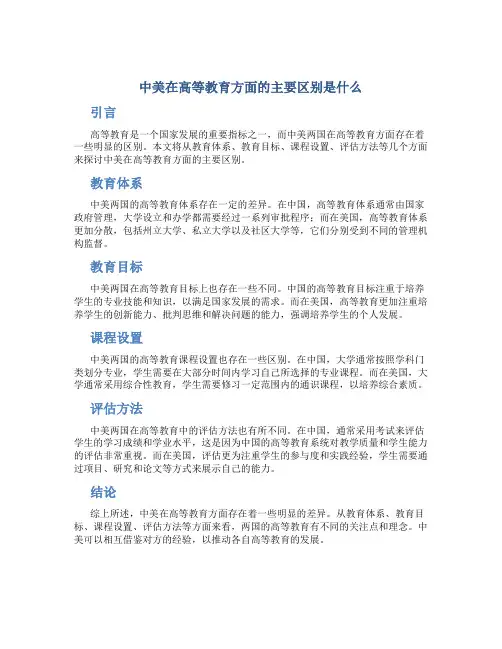
中美在高等教育方面的主要区别是什么
引言
高等教育是一个国家发展的重要指标之一,而中美两国在高等教育方面存在着一些明显的区别。
本文将从教育体系、教育目标、课程设置、评估方法等几个方面来探讨中美在高等教育方面的主要区别。
教育体系
中美两国的高等教育体系存在一定的差异。
在中国,高等教育体系通常由国家政府管理,大学设立和办学都需要经过一系列审批程序;而在美国,高等教育体系更加分散,包括州立大学、私立大学以及社区大学等,它们分别受到不同的管理机构监督。
教育目标
中美两国在高等教育目标上也存在一些不同。
中国的高等教育目标注重于培养学生的专业技能和知识,以满足国家发展的需求。
而在美国,高等教育更加注重培养学生的创新能力、批判思维和解决问题的能力,强调培养学生的个人发展。
课程设置
中美两国的高等教育课程设置也存在一些区别。
在中国,大学通常按照学科门类划分专业,学生需要在大部分时间内学习自己所选择的专业课程。
而在美国,大学通常采用综合性教育,学生需要修习一定范围内的通识课程,以培养综合素质。
评估方法
中美两国在高等教育中的评估方法也有所不同。
在中国,通常采用考试来评估学生的学习成绩和学业水平,这是因为中国的高等教育系统对教学质量和学生能力的评估非常重视。
而在美国,评估更为注重学生的参与度和实践经验,学生需要通过项目、研究和论文等方式来展示自己的能力。
结论
综上所述,中美在高等教育方面存在着一些明显的差异。
从教育体系、教育目标、课程设置、评估方法等方面来看,两国的高等教育有不同的关注点和理念。
中美可以相互借鉴对方的经验,以推动各自高等教育的发展。
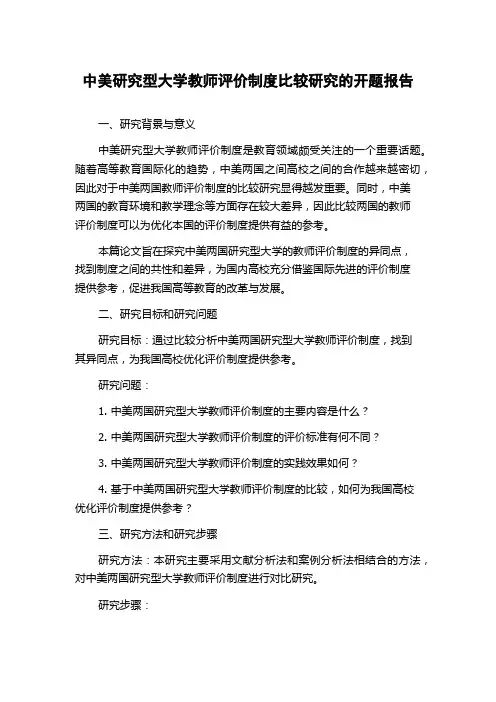
中美研究型大学教师评价制度比较研究的开题报告一、研究背景与意义中美研究型大学教师评价制度是教育领域颇受关注的一个重要话题。
随着高等教育国际化的趋势,中美两国之间高校之间的合作越来越密切,因此对于中美两国教师评价制度的比较研究显得越发重要。
同时,中美两国的教育环境和教学理念等方面存在较大差异,因此比较两国的教师评价制度可以为优化本国的评价制度提供有益的参考。
本篇论文旨在探究中美两国研究型大学的教师评价制度的异同点,找到制度之间的共性和差异,为国内高校充分借鉴国际先进的评价制度提供参考,促进我国高等教育的改革与发展。
二、研究目标和研究问题研究目标:通过比较分析中美两国研究型大学教师评价制度,找到其异同点,为我国高校优化评价制度提供参考。
研究问题:1. 中美两国研究型大学教师评价制度的主要内容是什么?2. 中美两国研究型大学教师评价制度的评价标准有何不同?3. 中美两国研究型大学教师评价制度的实践效果如何?4. 基于中美两国研究型大学教师评价制度的比较,如何为我国高校优化评价制度提供参考?三、研究方法和研究步骤研究方法:本研究主要采用文献分析法和案例分析法相结合的方法,对中美两国研究型大学教师评价制度进行对比研究。
研究步骤:1. 收集和梳理中美两国研究型大学教师评价制度相关文献和案例资料。
2. 对两国评价制度进行对比分析,找出其相似点与不同之处。
3. 结合实际案例,分析不同评价制度的优点和不足,评价其实践效果和可行性。
4. 基于比较研究所得,提出优化我国高校教师评价制度的相关建议。
四、预期成果1. 对中美两国研究型大学教师评价制度进行比较研究,找出其异同点。
2. 分析两国教师评价制度的实践效果和可行性。
3. 提出优化我国高校教师评价制度的相关建议。
中美政党制度比较概述政党制度是一个国家政治体制的核心组成部分之一,它对于国家的政治稳定和发展起着重要的作用。
在全球范围内,中美两个大国的政党制度具有较大的影响力。
本文将以中美两国的政党制度为比较对象,探讨其异同点,并分析其对两国政治发展的影响。
中美政党制度的背景中华人民共和国政党制度中华人民共和国政党制度是在中国共产党领导下的多党合作和政治协商制度。
中国共产党是执政党,其他政党则是执政协助的参政党,共同参与国家的政治决策和监督。
这种政党制度体现了中国特色社会主义政治制度的基本原则。
美利坚合众国政党制度美利坚合众国政党制度是建立在美国宪法基础上的两党制。
美国的两大主要政党是民主党和共和党,它们在竞选中争取选民的支持,通过选举来竞争权力。
这种政党制度体现了美国的民主和自由价值观。
中美政党制度的异同点党派数量和组织形式在政党数量方面,美国的政党较多,但民主党和共和党是最为重要的两大政党,占据主导地位。
而中国则采取了多党合作的制度,中国共产党是执政党,其他政党则是执政协助的参政党。
在组织形式上,中美两国的政党都是有组织的政治团体,但组织形式存在一定差异。
中国的政党更强调集中统一的领导,而美国的政党则更注重自治和内部竞争。
政治主张和意识形态中美两国的政党在政治主张和意识形态方面也存在差异。
中国共产党的主张是共产主义和中国特色社会主义,强调社会公平和经济发展。
而美国的民主党强调社会公正、人权和社会福利,而共和党则更注重自由市场经济和个人自由。
政党影响力和组织机构在政党影响力和组织机构方面,美国的政党更为强大和独立。
美国的政党通过选举和政府机构来行使权力,对政策制定和决策有更大的影响力。
而在中国,政党的影响力主要体现在参政议政、决策咨询等方面。
中美政党制度的影响中美两国的政党制度对两国的政治发展产生着重要影响。
政治稳定中华人民共和国政党制度通过多党合作和政治协商,实现了中国政局的相对稳定。
中国在政治上强调集中统一的领导,有效避免了政治分裂和权力竞争导致的社会动荡。
中美招投标制度对比一、背景介绍招投标制度是公共部门采购活动中非常重要的环节,旨在保障公平、公正、透明地进行采购活动。
中美作为世界上两个最大的经济体,其招投标制度也在不断发展和完善。
本文将对中美两国的招投标制度进行对比分析,探讨其异同点。
二、制度框架对比1. 中美招标制度概述中国招标制度:•由政府主导,遵循政府采购法规定•采购活动分为公开招标、邀请招标、竞争性谈判等形式•强调诚实守信,重视资质和市场行为规范美国招标制度:•以法律为基础,主要有《联邦采购规则》等法律法规约定•采购活动包括邀请招标、竞争性谈判、独家协商等形式•注重公开、竞争,强调供应商的平等竞争机会2. 制度特点对比中美招标制度:•中美都强调公平、公正、透明的原则,但在具体操作上存在一定差异•中美都重视资质和信誉,供应商应符合一定条件才能参与招标•美国更加注重竞争,而中国更加重视政府主导和管理三、流程对比分析1. 中美招标流程比较中国招标流程:1.项目立项2.编制招标文件3.发布招标公告4.接受投标文件5.开标、评标6.中标公示美国招标流程:1.定义需求2.制定采购计划3.发布招标公告4.接受投标文件5.评审投标文件6.中标公示2. 流程异同点分析•中美招标流程基本上相似,但在具体操作上存在一定的区别•中国招标更加注重政府的管理和干预,美国更注重市场的竞争机制四、制度优缺点对比1. 中美招标制度优势中国:•政府主导,有利于规范市场秩序•强调诚信和市场规范,有利于形成健康供应体系美国:•强调市场竞争,有利于提高效率和降低成本•采购程序规范,更有利于保障公平竞争2. 中美招标制度劣势中国:•存在一定的官僚主义和腐败问题•政府主导的特点可能导致市场竞争不充分美国:•竞争激烈可能导致较高的激励成本•部分供应商可能面临市场淘汰五、结论综上所述,中美招标制度在一些方面存在异同,我们可以借鉴对方的经验,不断完善自身的招投标制度,以促进公共资源的合理配置,实现经济的高效发展。
美国大学和中国大学的差异及特点无论美国人或中国人都有自己引以为荣的大学,如哈佛大学(Harvard University)、耶鲁大学(Yale University)和清华大学、北京大学,这些大学在创建的初期,就带有本国教育的特点和浓郁的民族文化气息。
无论你走进哪一所大学,毕业时你身上会或多或少地带有该大学独特的韵味,大学教育会影响到你的行为方式、处世态度、工作能力甚至你的一生。
大学教育这朵奇葩得以在人们的心中常开不败,永远鲜红,那么,花儿为什么这样红?让我们走近美国大学和中国大学,一睹各自的风采。
一、美国大学进门容易出门难,中国大学恰恰相反。
这种说法大体上是对的,但是在美国仍有一些大学比其它大学要难进的多,像哈佛大学,只有那些SAT( Scholastic Aptitude Test 学术评估测试)分数很高且高中总成绩也很高的学生才有可能进入哈佛大学,其它方面如volunteer work、体育音乐美术方面的特殊才能以及论文和入学面试等等,也对升入大学起到重要的作用。
而美国一般的大学对入学者并没有太高的要求。
在中国,入学考试(NMET)是衡量学生升入大学的唯一标准,这就忽视了学生其它方面技能的培养,造成少数学生“高分低能”想象的产生,不过,近年来,中国的高考制度已有一些改革,正在趋向完善。
这两种大不相同的入学标准体现了不同的文化底蕴。
美国的大学重视个人的创造力,这意味着他们不会仅仅通过一次考试来评价学生;而在中国,学生必须显示他们是通过努力学习以掌握丰富的知识,“学而不厌”“满腹经论”正是儒家思想的精华所在。
二、中美大学学费交付不同。
相对于本国经济状况而言,中美大学生的学费都是比较高的,中国学生的学费几乎都由家长支付,而美国学生则是通过银行贷款、奖学金、干临时工作来支付学费,也有某些家庭为孩子支付学费的,不过为数很少。
美国学生自己努力挣钱供自己上大学体现了他们的独立自主的精神,这与他们从小受到的教育有很大的关系,而且周围同龄人都独立自主,如果只有自己依靠父母就会觉得羞愧万分,别人也会看不起他;相比之下,中国学生对父母的依赖性就太强了,中国的父母深受儒家思想的影响,对孩子付出的爱太多太多,特别是在现在一个家庭只有一个孩子的情况下,对唯一的心肝宝贝更是疼爱得无以复加,为了孩子,父母做出再大的牺牲也在所不辞,这就加剧了孩子的对父母的依赖性,所以就有“在家靠父母,出门靠朋友”之说。
毕业论文中国和美国高等教育之间的差异The Differences of Higher Education between America and ChinaAbstractH igher education is an important approach to cultivate talented person. Different countries have different system of higher education. This paper aims at discussing the differences of higher education between China and America, and it not only puts forward the contrast analysis on the social environment, cultural tradition, education system and graduates ‘ability between China and America, but also analyzes the differences of the education reform measures between these two countries.Key words: Higher education; Difference; America; China中文摘要高等教育是培养人才的重要手段。
不同国家拥有不同体制的高等教育。
本文旨在讨论中、美两国高等教育的差异,它不仅提出了中、美两国社会环境和文化传统,教育制度和毕业生能力的对比分析,还分析了这两个国家教育改革措施的差异。
关键词:高等教育;不同; 美国;中国Contents:I. IntroductionII. Chinese-American social environment and cultural tradition differences2.1 Differences of attitudes on cultureIII. Chinese-American education system differences3.1 Different establishments of curricula and specialty3.2 Different choices of specialty curricula3.3 Different styles of inspecting students’ result3.4 Different styles of students’ management3.5 Different methods of teaching lessons3.6 Differences between public and private schoolsIV. Chinese-American graduates’ ability differences4.1 Differences of actual talents fosteredV. Chinese-American education reform measures differences 5.1 American reform measures5.2 Chinese reform measuresVI. ConclusionThe Differences of Higher Education between America and ChinaI. IntroductionIt is well known that higher education has been more and more significant all over the world. Because of the development of science and technology, the relationship between higher education and national politics, economy, science, culture, military is becoming closer and closer day by day. This mutual relation especially shows in aspect of higher education. The higher education is vigorous and upward, and it not only simply shows the growth of quantity, but especially has had the huge change in the nature. China and America share many characteristics in higher education. However this paper has mainly discussed the differences between Chinese and American higher education. The two countries are different in four significant aspects: (1)social environment and cultural tradition (2)education system (3)graduates ’ability (4)education reform measures.II. Comparison of the social environment and cultural tradition between China and America2.1 contrast of social environment and traditional education between China and AmericaAmerica is the biggest immigrant country. American economy emphasizes on the practical value, as well as individual value realization with fast development, rich material life, strong material idea and etc. The American advocates the independent way of life and work. The American owns full creative humanities spirit, the innovation is the forever subject in their brains. They pursue the hi-tech and prefer to compete.C ontrast with young USA, China is the great nation with glorious history and cultural traditions. The Chinese people have the excellent moral of modesty, but also have been over cautious and conservative. Though Chinese economy and technology is quite backward, it has very strong potential development, and Chinese students worked hard since they were small. Therefore China implements the policy of opening up, abundantly absorbs the benefit and enriches itself.The education between Chinese and American is extremely different. American education aims at building such an education to raise the creativity with less study and more thought. USA pays great attention to train the students’ practice ability to utilize the knowledge, cultivatingthe students to ask the knowledge and authority and building the ability to extend the knowledge system. That fact that 1/3 of numbers among all Nobel Prize winners in the world are the American is a very good illustration.Compared with American higher education, China’s higher education aims at building the foundation of education with more study and less thought; Chinese education pays more attention to instill and accumulate knowledge, cultivating the students’respect to the knowledge and authority and building the ability to inherit the knowledge system.III. Contrast of higher education system between Chinese and American3.1 different establishments of curricula and specialtyA nation’s higher education is the reflection of economic system. American education aims at adapting for society demand, they explicitly stipulate three big functions: education’s service for the economic development, the scientific research and teaching. The manifest of service in the establishment of specialty curriculum is to meet the social need and set up special curriculum or specialty which the society needs.In China's universities, during quite long period of time, the establishment of specialty curriculum lacks the change and could not follow social demand. In the latest few years, the majority of Chineseuniversities all started to pay great attention to the transformation and renewal of establishment of specialty curriculum so as to meet the need of society.3.2 different choices of specialty curriculaIn order to adapt the society, the American universities have established many specialties and curriculum of choice for students; the students choose or transform specialties and schools according to own interest and hobby. The American higher education system is extremely diverse and flexible, which is solo in the world higher education.In China, the student may choose the specialty according to own interest and hobby, but change of specialty in the school is not easy, transformation of school then is more difficult. In American universities, the compulsory courses are few, and elective courses are rich. While in Chinese universities, the compulsory subjects occupy the major part, and many schools(especially for technical colleges and universities)have the phenomenon of more emphasizing on the Science subjects, little on the liberal arts.3.3 different styles of inspecting students’ resultWhen American school inspects the result of student, they emphasize more on the ability to analyze and solve the question but not the ability of memory or description. The American student need the mechanical memorizing, but displays creative thought as far aspossible .This can cultivate students’study interest, raise the ability of doing it by self and make the study be one kind of creative activity.However, many teachers still adopted old teaching ways in Chinese universities, thus takes a test which needs mechanical memorizing. Such an inspection method has seriously attacked the students’ enthusiasm of study, caused the student to one-sidedly pay great attention to the theory and neglect the ability of practice.3.4 different styles of students’ managementIn the United States, many students at the school could conveniently take the IC card with a photo; the cards can be used to enter libraries and computer rooms and other facilities such as gymnasiums and other coliseum throughout the academy. Experienced consultants equipped by the school would help students to determine their main direction (major, a bit like our domestic professional) and guide students to choose specific classes. After selecting courses, in accordance with the school timetable, the septic time, place, classroom and course is entirely controlled by individual who means that everyone has the right of their own curriculum.Unlike American students, Chinese students also need arrangements of classes and dormitories. Compared with the USA’s IC card, our domestic student card and library card is similar to it. Except these, Chinese school has no experienced consultants to help students todetermine their main direction. As for the accommodation of students, some schools have a limited number of student dormitories, each school has a restaurant and fast-food shops, but most of them are always operated by outside operators where management are independent of schools. Most of students prefer to share a flat and live outside. So their dinner and lodging almost have no relationship with the school.3.5 different methods of teaching lessonsIn the United States inspiring students is great important for teaching. In classroom teachers will specially put forward some inspiring questions for students. In such a teaching mode, the students in the classroom have a higher degree of freedom, and they can be ready to make their own doubt for teachers which made the teaching atmosphere lively and vivid. This method of teaching helps to develop students’abilities of independent thinking and solving problem, however, this approach has a high demand for teachers which easily lead to a decrease in teaching quality and depth.China's higher education pays more attention to the systematic study. When teaching the curriculum, teachers should follow in accordance with certain teaching programs. Students have certain interactive questions, but this question tends to be discussed after the class, rather than in the classroom. It is the main mode that class is taught by teachers and students just listen to the records. This approachis conducive to help the students learn systematic knowledge. The class content is quite rich, but they have less sense of innovation.3.6 differences between public and private schoolsThere are more than 1500 public school of higher learning and more than 1600 private institutions in American. Both the public and private schools have a good reputation and high quality of the university. Very few Americans judge the quality not from the perspective of public and private schools, but from their teachers, courses and history.However, many Chinese believe that private schools can be unmatched with the public schools, and they are belittling or making an exclusion of private schools in heart. In private schools, Chinese people indeed should learn from the Americans, abandon the prejudice and make a correct and fair assessment for private schools.IV. Differences of quality and ability of graduates between China and US4.1 differences of actual talents fosteredIn actual talent fostered, the ability of adapting to society from American students was stronger than the Chinese Students. There are more and more opportunities to participate in social activities. Almost all the students have the experience of working outside. At the same time, civic education, campus cultural activities and community service activities in America increase the students’ability to adapt to thecommunity. While the Chinese Students stay under the closed campus for a long period,they have little direct ties to society and poorly understand the community, therefore Chinese students have to adapt to working atmosphere later than American’s students for two to three years.V.Difference of reform measures5.1 American reform measuresCurrently, American progress in the field of technology and knowledge occupies about 80 percent. The data is higher than one of the developed countries in Europe. Institutions of higher education should make indelible contribution to such a data. To meet the challenges of the 21st century, since the mid-1990s, the United States accelerates the reform of higher education systems which aimed at improving the quality of teaching and management efficiency and make greater contribution to the development of community and economy.Unprecedented expansion of social function of American University has become the power source for social development and progress. Therefore, the United States government policy-makers set off a new round of the 21st century-oriented reform of higher education to promote the development of higher education as a national goal of the important strategic initiatives.In the 21st century, the key point of American higher education reform is to achieve universal highereducation and make all over 18-year-old American youth have access to higher education.The overall idea of American Education reform is to build a higher education system which adapt to times’ demands. The most important measure is the reform of basic education and secondary education, the aim of idea is to meet the demand of adapting to the multiple reforms in future. To implement a strategic goal of universal higher education, the United States took a number of very innovative reform measures based on a substantial increase for education. These reform measures include: (1) implement small class teaching; (2) strengthen bilingual teaching, make college graduates more competitive and more adaptable; (3) improve the quality of teachers; in the system of employing teachers, schools take measures to employ formal teacher and informal teacher. In teaching methodology, teachers must adopt the modern teaching methods with integration of traditional media and modern media together for teaching.5.2 Chinese reform measuresRegarding the quality education as the most important thing, China's higher education implements the strategy of sustainable development, broaden the area of knowledge base, promote the integration of cross-disciplinary and connection between schools and society.Such a style aims at cultivating talents with a strong sense ofpioneering spirit, self-confidence, originality and boldly challenging the authority. China has been adhering to the reform of higher education for a long time. The most notable effect from the college merger is improvement of teaching effect. The College merger resolves some problems from the current teaching system uncoordinated with the international trend of socialization and market and enables educational resources to promote the effective allocation. The second measure is to set up the college courses in a market-oriented direction and adapt to the needs of society. Now in many school curricula’s is diverse, the initiative measures are taken to meet the needs of the market, at the same time a number of professionals closely related to social life are set up. The third initiative measure is based on the target of student-oriented.Since the 20th century, China's higher education emphasized the training of personnel ability, including the ability of acquiring knowledge, ability of analysis and problem-solving, ability of creating and certain organizational ability. At the same time the concept of quality education is put forward, which emphasizes the ideological and moral qualities, cultural quality, physical and mental quality. As a main part, students are not only the educated ones, but also participants of education.VI. ConclusionAll in all ,America’s higher education is different from China’s, it mainly performs through four points (1)social environment and cultural tradition (2)education system (3)graduates ‘ability (4)education reform measures. In order to reduce these differences, we should take some appropriate measures.In order to decrease the distance between Chinese higher education and American higher education, we should understand the difference of higher education between China and American, and absorb the advantages to profit from the American higher education and the development of our higher education. First of all, China's higher education should change from the "examination-oriented education" to "quality education". What is more, Chinese higher education should establish”people-oriented”education concepts. Besides, Student's sense of participation should be fully prominent in teaching practice. Teaching should focus on taking individualized teaching methods, strategies and techniques, widely apply the science teaching methods such as "free discussion", "self-study", make teachers and students exchange their ideas free, train students to learn initiative and creativity, promote students’initiative and creativity. Moreover, teaching management should achieve the reunification of system and flexibility.References[2] 丁往道,吴冰,英语写作基础教程[M],高等教育出版社,1998[1] 李泽同,透视美国[M],北京对外经贸大学出版社,2003[3] 史静寰,当代美国教育[M],北京社会科学文献出版社,2004[4] 吴明熹,教育政策的基本价值取向[J],高教研究参考,2006[5] 谢安邦,七方教育丛书[J],中国社会科学出版社,2001[6] 袁衍喜,现代教育改革探索[M],北京人民教育出版社,1987[7] 张文英,中美高等教育比较与启示[J],黑龙江高教研究,2005THANKS !!!致力为企业和个人提供合同协议,策划案计划书,学习课件等等打造全网一站式需求欢迎您的下载,资料仅供参考。
中美高校招生制度的比较美国和我国实施招生制度的起始在欧美的传统社会,由于接受高等教育是少数上层社会家庭子弟所享有的特权,因此,自中世纪大学兴起以来的很长时期里,大学的“入学条件基本上是以阶级、身份和是否付得起学费为标准”,少数贵族子弟只要通过专设的预备学校的毕业考试,即可进入大学就读。
18世纪资产阶级工业革命以后,随着各种为满足平民子弟入学需要开设的大量中等学校的出现,由上至下的上构型学制也逐步得以建立和完善,但是在学校有限的条件下,为合理限制入学人数,在西方一些国家首先实行了各级各类学校的入学考试制度。
直到第二次世界大战前,大多西方国家的高等学校基本上是实行入学考试制度。
大战后欧美等国为满足社会对高层次人才的需求立即迅速膨胀的个人入学要求,纷纷着手高等学校招生制度的改革。
特别是在当今时代,围绕着高等教育公平和学术优秀的价值观念,美国在探索中逐渐形成了带有本国特色的、相对稳定的高等学校招生制度。
而我国的招生制度也经历了从孔孟时期的私塾教育,家境好的上层子弟进入官学学习,多数平民百姓进入私塾读书,到汉代的“察举制”、魏晋南北朝时期的“九品中正制”,到隋唐代大兴科举考试制度,人们纷纷陷入“两耳不闻窗外事,一心只读圣贤书”的对“四书”“五经”的追逐中。
科举考试作为我国古代选举人才的一种方式,沿用了几个朝代。
直至明清时期被废除,退出了历史舞台。
新中国成立之后,我国开始逐步推行全国统一的招生考试。
两国的高校本科招生录取方式的比较(一)两国各类高校的本科招生录取方式1、美国的分类分层次的本科招生录取方式美国的高等学校的招生制度根据院校层次的分类不同,其新生的招生选拔制度也不尽相同。
美国大学按录取标准或政策可分为4类:第一类院校实行开放性的招生政策,如社区学院和4年制的州立大学。
其录取所有申请入学者,并且为那些不合格的学生补课。
第二类院校实行“最低限度筛选”的招生政策,占美国高等院校的大部分,它们接纳那些符合最低入学标准的学生,入学考试的目的是考查学生以便量才施教,而不是以此来决定是否录取。
第三类院校实行有选择性的招生政策,大约有200--300所,入学考试主要考查学生的一般能力,而不注重学业成绩,挑选的是中等成绩以上的学生。
第四类院校实行竞争性的招生政策,不超过100所,符合条件的申请者必须要有竞争,录取人数远少于报考人数,学能测验的分数名列全国所有大学考生分数的前10 %以内,绝大多数新生在中学的成绩也在全班前1/ 5以内。
2.我国的统一本科招生考试录取方式我国各个层次的院校主要参照统一文化考试的成绩开展录取工作,按成绩从高到低,同时结合考生自己填报的志愿录取新生。
它是以统一考试为主,单独考试为辅,报送生为补充的招生体系。
录取时按提前批次的院校、第一类本科院校(国家重点所属院校)、第二类本科院校(一般院校)和第三类本科院校(民办和高等职业技术院校)的顺序招录。
(二)两国的高校本科新生录取标准1.美国新生录取标准美国在授予学士学位的本科高校新生选拔工作中,将学生的SAT(或ACT)考试成绩、中学在校成绩、综合素质、特殊标准、推荐信等各方面表现都纳入考核选拔的标准,综合考虑,择优录取。
(1)高等学校入学考试成绩美国高校在接受学生的报名申请时一般首先要求学生提供SAT成绩或ACT成绩,作为决定录取学生的一个主要依据。
学能测验(SAT)是最为广泛采用的高校入学考试,它主要测验学生的综合学习能力和全国考生中的成绩排名。
高等学校测验(ACT) 包括英语、数学、自然科学和社会研究4个部分,考查学生的基本知识和技能,此项测验与学能测验颇为相似,在许多情况下互相取代。
(2)中学在校成绩在为期四年的中学学习阶段中,学校设选修课,实行学分制。
不同的大学根据专业录取的特点会对学生的在中学期间的必修或选修课程作出具体要求。
大学招生办也会根据学生的选课情况,分析学生的选修课程的动机和心理。
此外,许多美国高校规定了申请者四年中学平均成绩的最低值,以此考察学生的学习态度和学习能力。
另外,衡量学生的中学班级排名也是高校录取新生的参考条件之一。
大学招生办在审核申请材料时,也会着重审查学生成绩的发展趋势。
综合素质是美国高校在选拔录取新生时的一个具有代表性意义且不可或缺的重要标准,他们把每一个申请者当作特殊的个案来审视他或她具体的综合起来的能力和成就。
美国高校在录取新生时还有一些特殊的标准,一是注意吸收具有各种爱好和特长的学生,二是注重学生的多元化背景。
高校除了考察上述的方面以外,还要求学生持有某人的推荐信,通过此人对这个学生的一些认识和肯定而了解学生的一些特质。
2.我国新生录取标准因为我国现行的高校招生录取的选拔是以统一的文化考试为主,所以本科的录取标准是以学生的高考成绩为依据的分数标准。
(三)两国招生录取过程1.美国招生录取过程在美国,每所院校都设有专门的招生办公室或在其下设立了招生政策委员会和选拔新生委员会,分别负责制定招生计划、招生政策、招生数额、录取标准并甄选合格的新生。
高校具有很大的招生自主权,行政组织一般不干预。
学校对申请学生的审查录取,一般采取“择优录取”和“额满为止”的原则。
大学录取新生在家里通过网络和邮件的形式录取新生。
大学获取学生成绩的渠道有两条:一是考试机构根据考生的要求将成绩寄给所报学校(一所,也可几所);二是根据考生的要求向有关考试机构索要考生的成绩。
采取何种方式均由考生决定。
大学获取考生的成绩和有关资料后,即可根据自己的标准录取新生。
收到多份录取通知书的考生,需及早确定上哪一所学校,并及时将自己的决定通知各学校。
学校对只向某一所高校提出申请的学生会及早安排审查,尽快发出录取与否的通知。
同时向几所学校提出入学申请的学生,学校在审查后,一经决定录取就立即通知学生,并要求学生作出入学与否的表示,或规定在一定的期限内向学校回复,否则视为自动放弃入学资格。
除常规的招生方式之外,美国高校还普遍采用了早期决定录取资格、早期招生、学年中期招生、延期入学等其它几种招生方式。
2.中国招生录取过程高校招生录取方式是远程网上录取,时间是秋招为每年7-8月份,春招为每年1月。
网上录取就是将采集到的考生报名、体检,志愿、高考成绩等文字或图像信息,通过数字化处理载入计算机信息库中,建立考生的电子档案,在招生录取时再通过中国教育和科研计算机网(Cerner)和省级招办内部网(Intranet)将电子档案信息传递给有关招生院校。
招生院校的阅档、调档、录取和退档等工作都通过网络手段一并完成。
各省市分批次划定最低投档线,并按招生计划数的120%投档,按考生填报志愿,分批次进行录取,高考总分从高到低,择优录取。
除上文所述的全国统一招生外,一些高校在统招之外还会一定限度的采用提前招生、免试保送和自主招生。
美国高校本科招生录取方式对我国的启示(一)探索分层次的录取方式美国的大学入学选拔是以成绩、考试、中学时期记录为主要依据,其中最重视的是高中阶段的成绩在选拔中的作用,而不是只看入学考试的成绩,从而保证了入学选拔的准确性与公正性。
这种方法一是在选拔人才上采取综合评价的方法,录取标准既体现文化素质又体现能力和特长;二是学校分为不同层次,使不同层次的考生进入不同层次的高校,毕业后到不同层次的岗位上去工作,做到各取所需,人尽其才;三是允许考生双向选择,学生可以因对学校不满而转学,给高校带来了压力和紧迫感。
大学之间的竞争,促进各方面的发展;四是社区大学,不受年龄限制,充分扩大了接受高等的机会。
我国也要积极探索分层次的录取方式。
职业技术型的学校可参照美国的做法,向所有的高中生开放,以满足学生和家长对高等教育的需求,较高层次的高校录取新生主要是从培养不同类型的人才的要求出发,结合高校自身的特点,选拔适合培养需求的人才。
在选拔人才也需要建立一种新型的评价体系,将一些素质教育及平时表现纳入综合考虑的范围。
高校在以文化考核为依据的基础上,可增加面试、口试、实验测试等方式,考查学生综合素质,将中学校本评价与各阶段考试成绩纳入评价体系,全面预测学生的学习性向和发展潜力。
(二)采取灵活的录取时间和方式美国的高校一年四季都可以申请入学,高中在校生、往届毕业生、本州本国的学生及外国的学生都可提出申请,且美国高校总数多,学生选择范围大。
而我国除了一年一度的高考和推荐免试入学的保送生外,没有其它进入大学的可供选择的途径。
在大学就读期间,学生想转专业、转学就更加困难了。
高校招生实行的是考生由学校统一向招生机构提出志愿申请,考生的成绩最终汇总到学校,在这过程中学生的自主权无从体现,高校的录取以国家的需要为宗旨,很难考虑到个人意向,尽管有志愿选择,但实际上由于高等教育资源的稀缺及个人填报的盲目性,自愿往往落空,志愿调剂难免导致考生背弃自己的真实意愿。
我们可以参考借鉴美国的录取方式,采用志愿申报制度,使学生有选择的机会,减少填报志愿的风险。
实行志愿申报制度,要求高校要预先向社会公布其招生范围和录取标准供考生参考,在考生全面衡量自身条件与能力的基础上通过社会服务机构向中意的学校提出申请,考生可以同时申请几个学校,并接受学校的考核。
在双方相互衡量、相互选择后高校将学生录取到最合适其发展的学校,这种沟通与选择结合的方式能更好地体现了学生的自主选择权,也使得高校招到符合自身特色的学生。
(三)拓宽进入高校和学校之间流动的口径美国的有些高校对学生的要求很低,只要申请一般都能上,而且如果不想在一个学校继续读,转校也比较普遍,学校之间也可以互认学分,对学生来说有更大的自主择校的权利。
我国则没有相关的政策,一方面与我国的国情有关,我国的高等教育还没到完全普及,另一方面与我国的学校管理有关。
我国部分高校已经开展了一些象学校之间交流学习的活动,并互认学分,但在一定程度上还没有实现学生根据自己的意愿转校、择校。
(四)建立专业的考试机构美国有ETS等专门负责考试的机构,我国也应该健全社会服务机构,由专门的部门负责考试的安排。
考生可以直接向考试机构申请报考,考试成绩直接发给考生,作为考生向高校申请入学的证明之一。
通过此类社会服务机构统一考试,不仅减少了国家命题和高校单独命题繁忙的工作,提高了考试效率,也会减轻中学和考生为应付高考而带来的繁重的教学和学习任务。